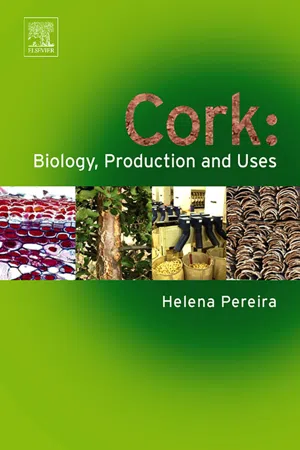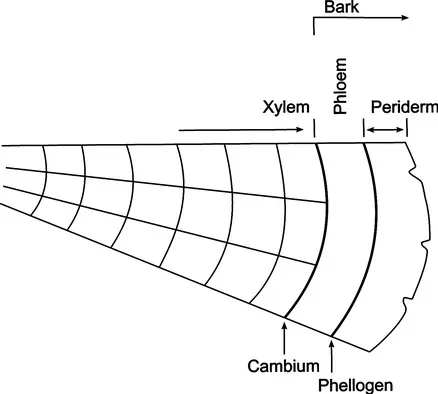
- 346 pages
- English
- ePUB (mobile friendly)
- Available on iOS & Android
eBook - ePub
Cork: Biology, Production and Uses
About this book
This comprehensive book describes cork as a natural product, as an industrial raw-materials, and as a wine bottle closure. From its formation in the outer bark of the cork oak tree to the properties that are of relevance to its use, cork is presented and explained including its physical and mechanical properties.
The industrial processing of cork from post-harvest procedures to the production of cork agglomerates and composites is described.
Intended as a reference book, this is the ideal compilation of scientific knowledge on state-of-the-art cork production and use.
- Presents comprehensive coverage from cork formation to post-harvest procedures
- Explains the physical properties, mechanical properties and quality of cork
- Addresses topics of interest for those in food science, agriculture and forestry
Frequently asked questions
Yes, you can cancel anytime from the Subscription tab in your account settings on the Perlego website. Your subscription will stay active until the end of your current billing period. Learn how to cancel your subscription.
No, books cannot be downloaded as external files, such as PDFs, for use outside of Perlego. However, you can download books within the Perlego app for offline reading on mobile or tablet. Learn more here.
Perlego offers two plans: Essential and Complete
- Essential is ideal for learners and professionals who enjoy exploring a wide range of subjects. Access the Essential Library with 800,000+ trusted titles and best-sellers across business, personal growth, and the humanities. Includes unlimited reading time and Standard Read Aloud voice.
- Complete: Perfect for advanced learners and researchers needing full, unrestricted access. Unlock 1.4M+ books across hundreds of subjects, including academic and specialized titles. The Complete Plan also includes advanced features like Premium Read Aloud and Research Assistant.
We are an online textbook subscription service, where you can get access to an entire online library for less than the price of a single book per month. With over 1 million books across 1000+ topics, we’ve got you covered! Learn more here.
Look out for the read-aloud symbol on your next book to see if you can listen to it. The read-aloud tool reads text aloud for you, highlighting the text as it is being read. You can pause it, speed it up and slow it down. Learn more here.
Yes! You can use the Perlego app on both iOS or Android devices to read anytime, anywhere — even offline. Perfect for commutes or when you’re on the go.
Please note we cannot support devices running on iOS 13 and Android 7 or earlier. Learn more about using the app.
Please note we cannot support devices running on iOS 13 and Android 7 or earlier. Learn more about using the app.
Yes, you can access Cork: Biology, Production and Uses by Helena Pereira in PDF and/or ePUB format, as well as other popular books in Technology & Engineering & Botany. We have over one million books available in our catalogue for you to explore.
Information
Part I
Cork biology
Chapter 1
The formation and growth of cork
Publisher Summary
The cork that is known from wine bottles is extracted from the bark of the cork oak tree. In plant anatomy, cork is a tissue named phellem and is part of the periderm in the bark system that surrounds the stem, branches, and roots of dicotyledonous plants with secondary growth. Cork is a protective tissue that separates the living cells of the plant from the outside environment. The formation of cork in the periderm is the result of the activity of a secondary meristem, the cork cambium, or phellogen. A general introduction to tree barks and to the formation of cork tissues in barks is presented in the beginning of this chapter. The formation of the first periderm in the cork oak is the illustrating by explaining the formation of the phellogen, the initiation of its meristematic activity, and the differentiation and maturing of cork cells as well as the differentiation and activity of the traumatic phellogens that originate the successive traumatic periderms that are formed during the tree exploitation. The formation and development of the lenticular channels in the cork tissue are also discussed. Finally, an analysis of the successive annual growth of cork is made in conjunction with a discussion on the sustained cork production.
The cork that we know from wine bottles is extracted from the bark of the cork oak tree (Quercus suber L.). In plant anatomy, cork is a tissue named phellem and is part of the periderm in the bark system that surrounds the stem, branches and roots of dicotyledonous plants with secondary growth. Cork is a protective tissue that separates the living cells of the plant from the outside environment.
The formation of cork in the periderm is the result of the activity of a secondary meristem, the cork cambium or phellogen. The cellular division of the phellogen is linked to the physiological cycle of the tree and to the factors that influence it, namely the environmental conditions.
In relation to other trees, the periderm of the cork oak has special characteristics of development, regularity, growth intensity and longevity that have singularised this species. Upon the death of the phellogen, even if in large areas of the stem, as it occurs during the man-made extraction of cork, there is a rapid formation of a traumatic phellogen that resumes its functions as a producer of the protective cork layer. This response of the tree is repeated whenever necessary. These features open up the possibility of using the cork oak tree as a sustainable producer of cork throughout its lifetime and they are the basis for the use of cork as an industrial raw material.
A general introduction to tree barks and to the formation of cork tissues in barks is made in the beginning of this chapter following the general description of plant anatomy (Esau, 1977; Fahn, 1990). The formation of the first periderm in the cork oak is detailed by showing the formation of the phellogen, the initiation of its meristematic activity, the differentiation and maturing of cork cells as well as the differentiation and activity of the traumatic phellogens that originate the successive traumatic periderms that are formed during the tree exploitation. The formation and development of the lenticular channels in the cork tissue are also presented. The analysis of the successive annual growth of cork is made in conjunction with a discussion on the sustained cork production.
1.1 Bark and periderm in trees
When looking at a cross-section of a tree stem, the distinction between two main parts can be made: the inner part is the wood (anatomically named xylem), located to the inside of the cambium, and the outer part to the outside of the cambium constitutes what is named bark (Fig. 1.1).

The bark is not homogeneous and is constituted by two types of tissues, from inside to outside: the phloem, produced by the cambium, and the periderm that is the result of the activity of another meristem, the cork cambium or phellogen. The phloem is the principal food-conducting tissue in the vascular plants, and it may be divided into an inner functional phloem and an outer non-functional phloem (also called non-collapsed and collapsed phloem, respectively). The periderm is a system with a three-part layered structure: (a) the phellogen, or cork cambium, is the meristematic tissue whose dividing activity forms the periderm; (b) the phellem, or cork, is formed by the phellogen to the outside; and (c) the phelloderm is divided by the phellogen to the interior.
In most tree stems, one periderm is only functional during a limited period, and it is substituted by a new functioning periderm ...
Table of contents
- Cover image
- Title page
- Table of Contents
- Preface
- Acknowledgements
- Introduction
- Part I: Cork biology
- Part II: Cork production
- Part III: Cork properties
- Part IV: Cork processing and products
- Index